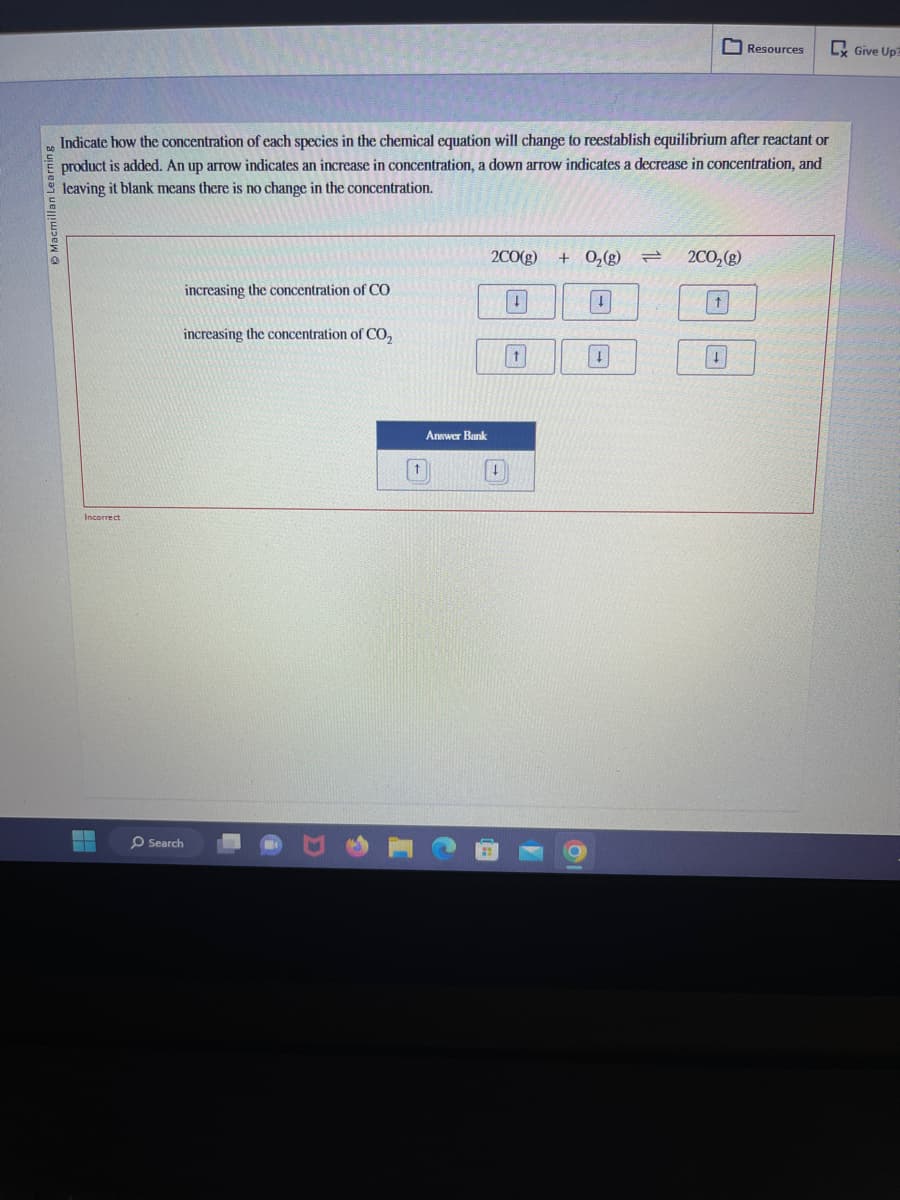Macmillan Learning Indicate how the concentration of each species in the chemical equation will change to reestablish equilibrium after reactant or product is added. An up arrow indicates an increase in concentration, a down arrow indicates a decrease in concentration, and leaving it blank means there is no change in the concentration. Incorrect ▬ increasing the concentration of CO increasing the concentration of CO₂ O Search Answer Bank 2CO(g) + O₂(g) = ↓ + 1 ↓ ↓ 2CO₂(g) t Resources Ly Give Up? +
Macmillan Learning Indicate how the concentration of each species in the chemical equation will change to reestablish equilibrium after reactant or product is added. An up arrow indicates an increase in concentration, a down arrow indicates a decrease in concentration, and leaving it blank means there is no change in the concentration. Incorrect ▬ increasing the concentration of CO increasing the concentration of CO₂ O Search Answer Bank 2CO(g) + O₂(g) = ↓ + 1 ↓ ↓ 2CO₂(g) t Resources Ly Give Up? +
Introduction to General, Organic and Biochemistry
11th Edition
ISBN:9781285869759
Author:Frederick A. Bettelheim, William H. Brown, Mary K. Campbell, Shawn O. Farrell, Omar Torres
Publisher:Frederick A. Bettelheim, William H. Brown, Mary K. Campbell, Shawn O. Farrell, Omar Torres
Chapter7: Reaction Rates And Chemical Equilibrium
Section: Chapter Questions
Problem 7.75P
Related questions
Question
100%
How can we indicate the concentration?

Transcribed Image Text:Macmillan Learning
Indicate how the concentration of each species in the chemical equation will change to reestablish equilibrium after reactant or
product is added. An up arrow indicates an increase in concentration, a down arrow indicates a decrease in concentration, and
leaving it blank means there is no change in the concentration.
Incorrect
▬
increasing the concentration of CO
increasing the concentration of CO₂
O Search
Answer Bank
2CO(g) + O₂(g) =
↓
+
1
↓
↓
2CO₂(g)
t
Resources Ly Give Up?
+
Expert Solution
This question has been solved!
Explore an expertly crafted, step-by-step solution for a thorough understanding of key concepts.
This is a popular solution!
Trending now
This is a popular solution!
Step by step
Solved in 3 steps

Knowledge Booster
Learn more about
Need a deep-dive on the concept behind this application? Look no further. Learn more about this topic, chemistry and related others by exploring similar questions and additional content below.Recommended textbooks for you

Introduction to General, Organic and Biochemistry
Chemistry
ISBN:
9781285869759
Author:
Frederick A. Bettelheim, William H. Brown, Mary K. Campbell, Shawn O. Farrell, Omar Torres
Publisher:
Cengage Learning

Chemistry by OpenStax (2015-05-04)
Chemistry
ISBN:
9781938168390
Author:
Klaus Theopold, Richard H Langley, Paul Flowers, William R. Robinson, Mark Blaser
Publisher:
OpenStax

Chemistry: An Atoms First Approach
Chemistry
ISBN:
9781305079243
Author:
Steven S. Zumdahl, Susan A. Zumdahl
Publisher:
Cengage Learning

Introduction to General, Organic and Biochemistry
Chemistry
ISBN:
9781285869759
Author:
Frederick A. Bettelheim, William H. Brown, Mary K. Campbell, Shawn O. Farrell, Omar Torres
Publisher:
Cengage Learning

Chemistry by OpenStax (2015-05-04)
Chemistry
ISBN:
9781938168390
Author:
Klaus Theopold, Richard H Langley, Paul Flowers, William R. Robinson, Mark Blaser
Publisher:
OpenStax

Chemistry: An Atoms First Approach
Chemistry
ISBN:
9781305079243
Author:
Steven S. Zumdahl, Susan A. Zumdahl
Publisher:
Cengage Learning


Chemistry
Chemistry
ISBN:
9781305957404
Author:
Steven S. Zumdahl, Susan A. Zumdahl, Donald J. DeCoste
Publisher:
Cengage Learning

Introductory Chemistry: A Foundation
Chemistry
ISBN:
9781337399425
Author:
Steven S. Zumdahl, Donald J. DeCoste
Publisher:
Cengage Learning